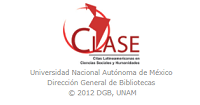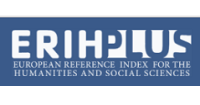Author’s Guide
Presentation and scope
The Latin American Journal of Social Sciences, Youth and Childhood is a scientific, peer-reviewed and multidisciplinary publication that is primarily dedicatd to the presentation of research results that, from the perspective of the social sciences, have children and youth as their central focus (and not just as a subsidary topic).
The journal is produced for a community of researchers who are interested in the theory and practice of studying, analyzing and deepening knowledge about children and young people, as well as for others who are interested in this topic with differ-ent objectives, for example the design, evaluation and comparison of programs and policies for children and youth.
The Journal publishes research and analysis, which, due to the high levels of quality and rigour, represent the main advances in the study of childhood and youth in Lat-in America and the Caribbean, or which debate knowledge and understanding relat-ed to this subject. The Journal receives contributions that respond to the complexity of this field of study and a range disciplinary, interdisciplinary and transdiscipli-nary perspectives (such as sociology, neurosciences, psychology, pedagogy and philosophy) and any methodological approach that is considered appropriate.
The Journal accepts articles in Spanish, Portuguese, French and English, preferably derived from research that has been formally endorsed by university institutions, research centres and public and private funding bodies.
The magazine has been published every six months since 2001 by the Centre for Advanced Studies in Childhood and Youth, which is a part of the CINDE NGO, and the University of Manizales (Colombia). These institutions finance its production and guarantee that the magazine is freely accessible to to the pubic. The magazine does not receive money for processing or publishing articles.
Types of articles and sections
The following types of articles are collected in the first (Theory and Meta-theory) and second (Studies and Research) sections of the journal. These articles receive double-blind peer reviews and are included in OJS as research articles:
-Quantitative research article. This presents the original results of completed em-pirical quantitative research projects. The structure of the articles should be adapted to the APA publication style (JARS-Quant, 7th edition, 2020) and include four main sections: introduction (including the contextualization and justification of the problem; the synthetic review of the most relevant and updated literature oon the topic; its objective and the research question or hypothesis), method (design; inclusion and exclusion criteria; characteristics of participants; sampling proce-dure; information collection method(s) and instruments; and data analysis strategy), results (that correspond to the instruments used) and discussion (similarities and differences of the results compared to research by other authors; interpretation of the results; limitations; importance and implications of the results with respect to future research, programs or policies).
-Qualitative research article. This presents the original results of completed empiri-cal qualitative research . The structure of the article should use the APA publication style (JARS-Quali, 7th edition, 2020), which is detailed in the Presentation Guide included on our website. It has four main sections: Introduction (including the con-textualization and justification of the problem; a critical and synthetic review of the most relevant and up-to-date literature on the topic; the objective and question used in the study), method (epistemological approach or position; design; description of the participants or data sources; process of selecting the participants; data collec-tion process(es); and data analysis technique), results or findings (that correspond to the instruments and the research approach used) and discussion (main contribu-tions; similarities and differences of the results with previous research; strengths and limitations; importance and implications of the results in relation to future re-search, programs or policies).
-Review article. A document that reports the results of the completed research and seeks to analyse, critique or integrate the results of other research on a specific problem area. Its purpose is to generate either a general conclusion to a problem (synthesis) or to identify trends, contradictions, relationships, gaps or problems in the specific area. This includes a general literature review, systematic literature re-views, meta-analyses and various types of meta-synthesis (meta-ethnography, criti-cal-interpretative synthesis, etc.). It is characterized by an exhaustive, systematic and careful bibliographic review (especially during the last three years) and original results that, above all, go beyond the mere summary of previous research. For its presentation, the APA style must be followed (JARS, 7th edition, 2020). The qualitiative version of the APA stle is pre-sented in the Guide for reporting review articles that is included on our website.
-Report/case study: This is a document that presents the results of completed re-search on an individual, group, community, organization or specific situation, in order to present the experiences, analysis or observations made, the resolution of a specific problem or the possible applications of the research that has been carried out. The presentation should include: introduction (with the corresponding litera-ture review, objective and question), methodological process for the analysis, an in-depth description of the case (and of analogous cases, if relevant) and the conclu-sions. This article should explain how the analysis carried out allows the general problem or other cases similar to the one analyzed to be understood/solved.
-Short article. This is a short document (no more than 4000 words) that presents the preliminary or partial results of a research study that is underway, but due to its im-portance requires prompt diffusion. Authors should bear in mind that the evalua-tion of this type of article will verify that its publication is indeed justified before the research has been completed. Its structure will be adapted to the format that suits the type of research being carried out (qualitative, quantitative, case study or review).
-Theoretical article. Document that draws on a research study and contains an ana-lytical, interpretative or critical perspective presented by the author on a specific topic. This is done to highlight progress with theoretical development, present a new theory on that topic or to analyze an existing one. As a derivative of an investiga-tive process, it must explicitly present the central aspects of the project: objective, question, method and process of analysis. Although its structure is more flexible than the article types mentioned previously, it should at least include: an introduc-tion (with the contextualization of the problem and the presentation of relevant lit-erature up to the year in which the article is written), the process of collecting and analyzing the information, theoretical development and conclusions.
Other types of intellectual production are also received and published in the third (Reports and analysis) and fourth (Reviews) sections; these are not included in the OJS of the journal (as they are not research articles) but they are published on our website so that they are available to our readers:
-Reflective article (essay). A document that presents either critical analysis or theo-retical reflection on a particular topic; but unlike a theoretical article, it is not based on formal research. The author(s) must clarify the interpretative process that has been carried out. This type of article should also accommodate references using the APA style (2020). Only essays that the Editorial Board consider a significant contribution to knowledge in the area will be published.
-Interviews. Conducted with experts in the field of children and youth, this presents interesting and current conversations. The interviewer can add comments, points of view and theoretical developments that contribute to the document.
-Letters to the editor. Critical, analytical or interpretative positions regarding the documents published in the Journal which, in the opinion of the Editorial Commit-tee, constitute an important contribution to the discussion of the subject by the rel-evant scientific community. These letters are included in the fourth section.
-Others. We also receive brief analyses of works, audiovisual material, events, local processes and projects that are currently being implemented that are original and of interest to social researchers and others. We also receive systematizations of stud-ies related to children and young people and child and youth-led research.
As these documents do not have the character of a scientific article and are not peer-reviewed, they can be more freely formatted (although they must maintain ci-tation standards). However, given their unpublished nature, they are assessed for originality and their style correction in the Journal’s editorial process.
Editorial parameters
The opinions and statements that appear in the articles and other documents are the sole responsibility of the authors.
The entry of an article into the Open Journal System (OJS) by this Journal implies a commitment by the author to not submit it partially, completely nor simultaneously to other journals or publishers without first withdrawing the text from consideration by this Journal through written communication.
Articles must be submitted by authors to the OJS platform of the Journal using the format available on our website download here. Once this process has been completed, it will be subjected to a plagiarism check using the UnicheckTM program to verify that it is unpublished.
It should be taken into account that, if the article is derived from a thesis, and this thesis has been deposited in the public institutional repository of a university through a transfer of copyright, verbatim texts from that document cannot be used (unless they are cited) as the it is considered that this content has already been pub-lished and would thus be self-plagiarism (even if the document is in another lan-guage).
Presentation standards
The following are the standards that must be met by the articles in the Theory and Meta-theory (Section 1) and Studies and Research (Section 2) sections. Please note that these standards are strictly adhered to, so manuscripts that do not conform to them will be returned to their authors.
1. Title: this should synthetically reflect the central topic covered by the article. Its length should not exceed twelve words and it should include words that make it eas-ier for readers to find it through digital search systems. The title should be present-ed in the three languages used by the journal: Spanish, English and Portuguese. Au-thors should include a short title (maximum 30 characters) in brackets below the full title that can be included at the top of the pages of the article. The short title does not need to have the same word order as the title, but should present the cen-tral idea of the title in a summarized form.
2. Name and affiliation: the standardized name of the author(s), followed by their corresponding affiliations (the institution where they worked or studied when they carried out the research, along with their department or faculty), city and country should be submitted. If an author has no affiliation, only their city and country will be listed. Then they will present their academic level (previous studies and their most advanced degree along with the institutions), e-mail address, their Orcid code (https://orcid.org) and finally their H5 index. If your affiliation has changed since the study was conducted, include this information in this section (e.g., "author x is now affiliated with university x").
Standardization and consistent use of the name(s) and surname(s) of each author, according to international standards, is important.3 If any of the authors is referred to within the article or in the list of references, this same standard should be fol-lowed, since this facilitates searches for authors at the international level and their visibility in bibliometric indexes.
The following is an example of the name of the author with institutional affiliation and the data included:
Jorge I. González
Faculty of Economic Sciences, National University of Colombia, Bogotá.
Philosophy Degree from the Javeriana University, Master’s in Economics from the Uni-versity of Los Andes, Doctor in Economics from the University of Leuven (Belgium). Orcid: 0000-000x-xxxx-xxxx. H5: x. E-mail: author@institution.edu
3. Type of article: the type of article submitted should be specified so that its edito-rial processing is based on its content. Please take great care to choose the article type that is most appropriate for the research undertaken, as well as to comply with the required characteristics. Errors in this area are the most common reason for re-jection.
4. Information about the study: the exact date (hopefully the day, or at least the month and year) of the start and end of the investigation, and whether the investiga-tion is still ongoing (if applicable), must be indicated. Also, the name of the entity funding the research (if any) and the respective code are required. This information should not exceed 100 words. The following are examples of articles that have al-ready been published in the journal
-This article is a synthesis of the research titled "Cultural hermeneutics of health", pre-sented by the author as their thesis to obtain the title of Doctor in Sociosanitary Scienc-es and Medical Humanities, Universidad Complutense de Madrid, 2003. Funding was approved at the meeting of the Higher Council of the University of Manizales, Record 019 from September 23, 1999. The research was carried out between February 12, 1999 and September 30, 2002.
-This article is based on the research project titled "Towards an understanding of the construction of meanings about upbringing in the growth and development program", financed by the University of Antioquia and registered in the Research Center of the National School of Public Health at the University of Antioquia with the code INV-168-05. The research was conducted between February 23, 1999 and November 15, 2002. The data and analysis from the research are openly available at https://osf.io/xxxxx.xxx
5. Abstract: with a maximum of 130 words, this is a complete summary that is used in search services to index and retrieve the article. As a result, it must be interesting and precise so that it attracts the attention of potential readers.
If the article presents the results of a research study, the summary should be analyt-ical, mentioning the problem, participants and the methodology used, as well as the main results and conclusions from the research. It should not begin by presenting the objective or commenting on the content of the article. It should also not contain any bibliographical references or acronyms.
In the case of articles that do not present the results of a research study, a descrip-tive summary should be used that expresses in a synthetic, clear and precise way the content of the article. This should also be less than 130 words and it should be made clear at the beginning that it is a descriptive summary.
6. Key words: following the summary, some key words (from 3 to 10) are required to quickly identify the topic of the article. The key words, without exception, should be taken from a Social Sciences thesaurus, indicating the name of the thesaurus (at the end of the list).
The title of the article, the abstract and the keywords must be translated without exception into Portuguese (abstract, palavras-chave) and Spanish (resumen, palabras claves) by a technical translator with expertise in the social sciences.
7. Body Text
- Extension: articles have no maximum word limit. However, economy of language is recommended. For reference, the average published article is 7,500 words (in-cluding the title and the list of references).
- Footnotes: footnotes must use the automatic WordTM style. Their number and extension should be limited as much as possible in order to not affect the readabil-ity of the article.
- Inclusive language: inclusive gender language should be used when writing the article.
- Tables and figures: Tables and figures (graphic material) are listed in the order that they are mentioned in the text. They should have a precise and informative title before them. Their presentation must comply with the APA style (7th ed., 2020) based on the model included in the presentation format. Tables and figures that are subject to copyright or other restrictions should not be included without prior writ-ten permission from the original author. Without the fulfilment of this requirement it is not possible to include the material. This permission must be detailed in a note at the end of the article. Tables and figures preapred by the authors of the manu-script should not have any credits as to their authorship. Within the text of the arti-cle, each table or figure should be referenced by its number (e.g. Figure 2) and not by phrases such as "the following table", as the graphic design process may require placing them in a location that is different to where they are referenced. In the spe-cific case of photographs, the faces of children should not appear without the writ-ten concent of their parents or guardians. In the case of photographs of adults, it is also recommended that informed consent be obtained.
- Attachments: no attachments should be included at the end of the article. They should all be incorporated into the body of the article as indicated above (tables, graphs, photos, etc.) However, the author can present digital annexes (through links), if and when these documents are archived in services that facilitate the in-definite hosting of this information and provide DOI codes (for example, https://figshare.com or https://osf.io). This information can be included both in the body of the text and in footnotes.
- Reference system: The the latest version of the APA reference system (7th ed., 2020) will be used. For example:
... as explained in Rogoff and Pilsen (1993)
... as they argued (Rogoff & Pilsen, 1993).
... in the words that they used (Rogoff & Pilsen, 1993, pp. 31-32).
When referencing works with three or more authors, it is only necessary to cite the first author followed by the abbreviation et al. (when they are included in the text of the article or in parentheses).
8. Reference list: this must include all (and only) sources cited within the text (in-cluding tables, graphs and notes). This list should follow the APA style (7th ed., 2020)4 . Example:
Hedegaard, M. (2005). Strategies for dealing with conflicts in value positions between home and school: Influences on ethnic minority students’ development of motives and identity. Cultural Psychology, 11(2), 187-205. https://doi.org/10.1177/1354067X05052351
References must include current sources (from the last three years, including the current year) and be relevant, pertinent, sufficient and necessary. It is also im-portant to cite authors who are considered classics in each field.
Evaluation and review process
The journal - with the consent of the author(s) - will make any editorial changes necessary to give the article the greatest possible clarity, precision and coherence. Consequently, it is recommended that authors write with rigor, using good spelling, short, homogeneous and clear paragraphs and accurate punctuation. Redundancies in the text and the repetitive use of acronyms should be avoided as they make read-ers tired and cause them to lose motivation to read their text. Before they send it to the Journal for consideration, authors are asked to send their manuscript to a spe-cialist proofreader or style corrector (who has worked with the APA style and in the field of social sciences) so that the editing process can be expedited.
Once the article is uploaded by the author to the Journal’s OJS (Open Journal Sys-tem), the author must send certification from the proofreader to the Journal’s e-mail addres. Subsequently, the article will receive an initial evaluation by the Editorial Committee.
In this evaluation, compliance with the standards presented in this document, the coverage of the subject matter and the general quality of the journal are reviewed. Multiple corrections and non-acceptance can result from this review.
Articles that pass this stage are subject to a double-blind peer review by at least two evaluators. Once the proposed document has been evaluated, the author(s) will re-ceive comments for the article’s review and adjustments. They will receive a dead-line from the Editor of the Journal for returning the article with the necessary changes highlighted. Based on the opinion of the evaluators and/or the editorial team, the corrected article may be sent to a second peer review.
By submitting the article to the Journal’s editorial process, all authors agree to the transfer of copyright to the Journal in case the article is approved for publication. This agreement allows the editorial team to protect the material on behalf of the au-thors without them losing their copyright. The transfer of rights includes exclusive rights to reproduce and distribute the article, including physical copies, photocop-ies, digital and other formats and translations.
A proof of the articles will be sent to the author(s) before the journal is printed. Corrections should be limited to typing errors. No new lines, sentences or para-graphs will be accepted. The page and line numbers for each error need to be indi-cated on the proof.
The journal's OJS (Open Journal System) facilitates online communication so that journal authors can keep track of the status of their article. Its address is: http://revistaumanizales.cinde.org.co/rlcsnj/index.php/Revista-Latinoamericana/login
Contact address of the magazine: revistaumanizales@cinde.org.co
1 These can be found at https://apastyle.apa.org/jars/quantitative. Remember that this is only a guide and you should use the elements that best apply to your research.
2 H5 is one of the most widely used metrics today. It compares the number of articles published by an author against the num-ber of citations received. You can get it through your author page on Google Scholar.
3 Information on this can be found on the website http://www.iralis.org/es
4 Examples of the most common types of references can be found at https://apastyle.apa.org/style-grammar-guidelines/references/examples















